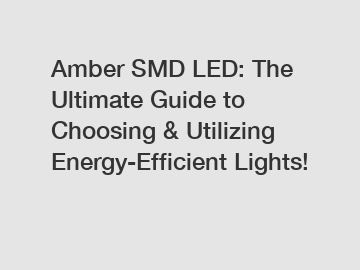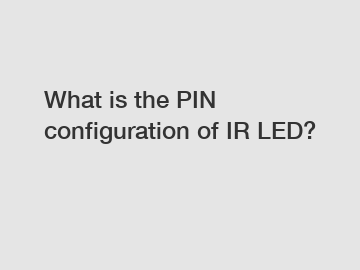LED COB and LED SMD: A Few Things You Need to Know
LED COB and LED SMD: A Few Things You Need to Know
Characteristics of SMD LEDs:
If you are looking for more details, kindly visit Moonleds.
SMD LEDs possess several unique characteristics that make them popular in various lighting applications. They are directly applied to the surface of circuit boards, eliminating the need for additional leads and reducing material usage. Their wide luminous angle, usually around 120-160 degrees, allows for even illumination and enhanced visual appeal. Moreover, SMD LEDs operate at lower voltages and currents, resulting in reduced energy consumption and heat generation, which contributes to their extended lifespan and improved stability. Additionally, the presence of three single-color LED units (red, green, and blue) within each LED enables SMD LEDs to achieve multi-color or full-color displays, providing versatility in lighting effects.
Understanding COB LEDs:
Now, let's turn our attention to COB LEDs, an advanced chip-level packaging LED technology. COB LEDs break away from traditional discrete packaging by densely integrating multiple LED chips onto an insulating layer and an aluminum substrate (heat sink) of various shapes, such as round, square, rectangular, moon, or star.
Characteristics of COB LEDs:
COB LEDs offer several unique characteristics that make them a preferred choice for specific lighting applications. The tightly packed multiple LED chips result in increased light output per square inch, allowing COB LEDs to achieve impressive brightness levels in a compact form. Furthermore, COB LEDs require only one circuit and two contacts to drive the entire array of chips, simplifying circuit design, reducing energy consumption, and lowering the risk of failure. Unlike traditional LEDs, COB LEDs do not have leads, phosphorescent layers, or lenses, which can reduce the light-emitting area (LES) and increase the central beam candle intensity (CBCP). This enhances light efficiency and reduces light loss. The substrate material and heat sink of COB LEDs exhibit excellent heat dissipation properties, ensuring that the heat generated by the chips is effectively conducted, resulting in low-temperature operation, prolonged LED life, and improved stability.
COB LEDs vs. SMD LEDs: A Comparison:
Now that we have explored the characteristics of both COB and SMD LEDs, let's compare them based on several key aspects:
1. Brightness:
COB LEDs offer higher light output and center beam candle intensity due to their densely packed multiple LED chips. This makes them suitable for applications requiring high brightness and focused lighting, such as spotlights and downlights.
SMD LEDs may not achieve the same brightness level as COB LEDs in a single chip. However, their advantage lies in producing uniform and soft lighting over a wider luminous angle, making them ideal for even illumination in applications like strips and bulbs.
2. Energy Efficiency:
SMD LEDs generally have higher energy efficiency than COB LEDs. They can produce more lumens per watt, meaning they achieve the same brightness with less energy consumption, making them more cost-effective in the long run.
COB LEDs, while not as energy-efficient as SMD LEDs, can still deliver high brightness levels in a smaller size due to their higher lumens per square inch. This space efficiency can be advantageous for certain applications.
3. Color:
SMD LEDs can achieve multi-color or full-color displays, thanks to the presence of three single-color LED units. By adjusting the brightness of each unit, different colors can be produced, allowing for versatile lighting effects and dynamic color changes.
COB LEDs, however, are limited to emitting light of a single color and color temperature due to their uniform phosphorescent layer. As a result, they are more suitable for applications requiring a consistent single-color output.
Vorlane SMD LED Strip Light4. Heat Dissipation:
COB LEDs are designed with multiple LED chips mounted closely together on a thermally conductive substrate, enhancing heat dissipation. This effective heat dissipation contributes to a longer lifespan and improved stability, especially in applications where the LEDs operate for extended periods or in high-temperature environments.
SMD LEDs, while efficient in heat dissipation, generate more heat and temperature compared to COB LEDs. The need for separate circuits and contact points for each chip, as well as the traditional LED package structure, contributes to the slightly higher heat output.
5. Cost:
The cost difference between COB and SMD LEDs is multifaceted. While COB LEDs may be more cost-effective in terms of simplified production processes, they require better materials and heat dissipation solutions. On the other hand, SMD LEDs involve separate substrates and phosphor layers for each chip, as well as more complex circuit design and production processes. However, advancements in automation have reduced production costs for SMD LEDs, making them more cost-competitive in certain scenarios.
In conclusion, both COB LEDs and SMD LEDs have their unique strengths and weaknesses, making them suitable for different lighting applications. The choice between COB and SMD LEDs depends on the specific requirements of each application. If brightness, high concentration of light, and cost-effectiveness are the primary concerns, COB LEDs may be the better choice. On the other hand, if uniformity of light, energy efficiency, and versatile color options are more important, SMD LEDs may be the preferred option.
6. Environmental Footprint
In the quest for greener solutions, COB and SMD LEDs stand out. These tiny lights pack a punch, not just in brightness but in sustainability. Consuming less power than traditional bulbs, they slash energy use and carbon emissions, making a significant environmental impact. Plus, their longer lifespan means fewer replacements and less waste. As we illuminate our spaces, choosing COB and SMD LEDs is a step towards a brighter, more sustainable future, proving that good things do indeed come in small, energy-efficient packages.
Why COB LEDs Require Better Substrate Heat Dissipation:
Now, let's delve into why COB LEDs have higher substrate heat dissipation requirements than SMD LEDs. To understand this, we need to consider the heat generation and photoelectric conversion efficiency of both LED types.
COB LEDs generally have lower photoelectric conversion efficiency compared to SMD LEDs. The reason lies in the use of more phosphors to mix white light in COB LEDs. This process involves the absorption of some blue light by the phosphor and silica gel, which converts it into heat. Additionally, the package structure of COB LEDs contributes to higher heat generation.
COB LEDs are created by directly mounting multiple chips onto a substrate to form a high-density light-emitting surface. In contrast, SMD LEDs are encapsulated single chips attached to brackets, resulting in a dispersed light-emitting point. As a result, the heat and light energy density on the light-emitting surface of COB LEDs is higher than that of SMD LEDs, leading to higher temperatures.
However, it is essential to note that while the surface temperature of COB LEDs may be higher than that of SMD LEDs, the actual chip temperature of COB LEDs can be lower than SMD LEDs. This is due to the more effective heat dissipation design of COB LEDs, with the chip directly mounted on the substrate with better heat conduction.
The Advantage of Aluminum Substrate in COB LEDs:
COB LEDs require effective heat dissipation to maintain optimal performance and extend their lifespan. This is where the advantage of an aluminum substrate in COB LEDs becomes apparent.
Aluminum substrate boasts superior thermal conductivity compared to traditional PCB copper substrates. The smaller thermal resistance of the aluminum substrate allows heat generated by the chips to be quickly transferred to the heat sink, effectively dissipating the heat and keeping the LEDs operating at lower temperatures.
Additionally, aluminum substrates have a low coefficient of thermal expansion, which means that at high temperatures, they have relatively little dimensional change. This prevents changes in the thickness and flatness of the board due to high temperatures, which can impact the quality of metallization holes and lines.
Explore more:Exterior & Facade Lighting
5 Commonly Used Outdoor Wall Facade Lighting
Facade lighting: correctly illuminating facades
Key Questions to Ask When Hiring Tree Trimming Services
Transform Your Home: Top Garden Spike Light Benefits Unveiled
Explode-Proof LED Lights: Ultimate Safety Guide for Hazardous Areas
Unveiling the Brilliance: Unraveling Cree LED Technology
For more smd led bulb circuit diagraminformation, please contact us. We will provide professional answers.
Furthermore, aluminum substrate enables COB LEDs to carry higher current due to the use of copper foil for wire connections. In comparison, traditional PCB copper substrates may have higher thermal resistance, limiting the current-carrying capacity.
In summary, COB LEDs require better substrate heat dissipation due to their higher heat generation and photoelectric conversion efficiency. The use of aluminum substrate in COB LEDs ensures optimal heat dissipation, extended lifespan, and improved stability, making them suitable for applications with long working hours and high-temperature environments.
COB LEDs and SMD LEDs in Luminaire Manufacturing Applications:
The choice between COB LEDs and SMD LEDs plays a crucial role in luminaire manufacturing applications. Each type has distinct advantages that cater to specific lighting requirements. Let's explore how COB and SMD LEDs differ in various applications:
1. Applications of SMD LEDs:
SMD LEDs are particularly well-suited for products that require wide-angle lighting and even illumination. Due to their wide luminous angle, usually around 120-160 degrees, they are commonly used in strips, panels, bulbs, and various architectural lighting applications. SMD LEDs offer versatility in color and can achieve multi-color or full-color displays, making them ideal for dynamic lighting effects.
2. Applications of COB LEDs:
COB LEDs excel in applications that demand high brightness, concentrated light, and superior luminous efficiency. The tightly packed multiple LED chips result in increased light output per square inch, making COB LEDs suitable for spotlights, downlights, streetlights, and other high-brightness lighting fixtures. COB LEDs are also favored in industrial and commercial lighting applications where extended operation in high-temperature environments is required, thanks to their efficient heat dissipation design and extended lifespan.
Troubleshooting COB LEDs and SMD LEDs:
Now, let's learn how to troubleshoot COB and SMD LEDs to identify any issues they may have. Here are some methods you can use to determine the condition of your LEDs:
1. Power-Up Test:
Power up the SMD or COB LEDs using a battery or power supply and observe if they emit light properly. If the LEDs do not light up, there may be a problem with the lamp beads, such as damage or poor contact.
2. Multimeter Test:
Use a multimeter to measure the positive and negative terminals of the SMD or COB LEDs in the diode gear. If you can measure normal resistance values or conduction voltage, it indicates that the lamp beads are not burned. If you cannot measure any value, it suggests that the lamp bead may be shorted or open circuit.
3. Visual Inspection:
Observe the appearance of the SMD or COB LEDs with the naked eye. Look for cracks, discoloration, deformation, or other abnormalities. Any of these signs may indicate that the lamp beads have been damaged due to overheating, overvoltage, or mechanical shock.
Remember that these methods can provide an initial assessment of the condition of the LEDs. For more precise performance parameter testing, professional instruments like spectrometers and optoelectronic parameter testers may be required.
Replacing Bad COB LEDs or SMD LEDs in LED Products:
If you have identified any faulty COB or SMD LEDs in your LED products, here's a guide on how to replace them:
1. Removal of Bad LEDs:
Use a hot air gun or soldering iron to remove the bad COB or SMD LEDs from the board. Take care not to damage the board or other components during this process.
2. Cleaning and Preparing the Board:
Remove excess solder from the board with a soldering iron, leaving a thin layer of solder for easy mounting of the new COB or SMD LEDs.
3. Replacement of LEDs:
Replace the bad COB or SMD LEDs with the same type of LEDs purchased online. Pay attention to the correct orientation of the positive and negative poles during the replacement.
4. Soldering:
Heat the back of the board with a hot air gun or soldering iron until the solder on the front side melts, firmly soldering the new LEDs in place. If the LEDs have intermediate heat sink pads, solder them together as well.
5. Testing:
Check if the new COB or SMD LEDs emit light properly. If any issues persist, repeat the steps and ensure proper connections.
It is important to note that the above method requires a certain level of hands-on skills and access to specific tools. If you lack experience or complete tools, consider replacing the entire light board as an alternative.
Conclusion:
We hope this comprehensive guide has been helpful in understanding the fascinating world of COB and SMD LEDs. These innovative technologies have transformed the lighting industry and continue to offer versatile solutions for various applications. When choosing between COB and SMD LEDs, consider the specific lighting requirements and characteristics of each LED type to make an informed decision. Whether you are a luminaire manufacturer or an LED enthusiast, the right choice of LEDs can bring brilliance and efficiency to your lighting solutions.
As a professional LED luminaire manufacturer, Vorlane is here to support you with our expertise and high-quality LED products. If you have any questions or need further assistance with COB or SMD LEDs, please do not hesitate to contact us. Let's together illuminate a brighter future with cutting-edge LED technology!
Please help me with this LED circuit.
First of all I'm a newbie in electronics so please don't get angry with my primitive questions.
Concept:
I want to use LED's as back-light for a LCD monitor.
(Powers is perfect but inverter is gone and parts are not available. they want 65$ for a "used" "repaired" inverter so I decided to do this)
=========================================
I read a lot about back lighting and other things. finally found a probably good circuit diagram for my purpose in a Russian site (used Google translate).
here it is:
the circuit seem perfect for me but I have to do some modifications:
1. I have to use 60 LED's
2. I want to have the option of dimming the LED's (not logical, a simple potentiometer would be OK).
Now what I want to know:
1. Is it better to make two units for every 30 LED's?
2. this circuit has 41 LED's but I want to use 30 or 60, what should I do? 3 rows of 10 LED's? 4 rows of 15 LED's? or else?
3. I found a website (**broken link removed**) that calculates all the values and give the parts, but I'm confused because:
a) It wont give standard values for the parts. (the most important of them for me is L1)
b) I don't know how to configure the LED's so I can't calculate needed voltage and other parameters.
what I have:
1. 14V power source.
2. 60 LED's (SMD-) VF 3.2v, If 20mA, Pd 173mW.
3. 5 volts on/off signal to feed the FET for turning on/off the circuit.
OK, I know it's kind of rudeness but the final request would be:
1. LED configuration.
2. part values.
Any suggestions would be appreciated even referring me to further reading would be OK.
Thank you
HiFirst of all I'm a newbie in electronics so please don't get angry with my primitive questions.Concept:I want to use LED's as back-light for a LCD monitor.(Powers is perfect but inverter is gone and parts are not available. they want 65$ for a "used" "repaired" inverter so I decided to do this)=========================================I read a lot about back lighting and other things. finally found a probably good circuit diagram for my purpose in a Russian site (used Google translate).here it is:the circuit seem perfect for me but I have to do some modifications:1. I have to use 60 LED's2. I want to have the option of dimming the LED's (not logical, a simple potentiometer would be OK).Now what I want to know:1. Is it better to make two units for every 30 LED's?2. this circuit has 41 LED's but I want to use 30 or 60, what should I do? 3 rows of 10 LED's? 4 rows of 15 LED's? or else?3. I found a website () that calculates all the values and give the parts, but I'm confused because:a) It wont give standard values for the parts. (the most important of them for me is L1)b) I don't know how to configure the LED's so I can't calculate needed voltage and other parameters.what I have:1. 14V power source.2. 60 LED's (SMD-) VF 3.2v, If 20mA, Pd 173mW.3. 5 volts on/off signal to feed the FET for turning on/off the circuit.OK, I know it's kind of rudeness but the final request would be:1. LED configuration.2. part values.Any suggestions would be appreciated even referring me to further reading would be OK.Thank you
For more information, please visit anode cathode smd led.
Which Aspect of SMD LED Tube Lights Boosts Energy Efficiency the Most?
Revolutionizing Audio Experience: Philips by718p Headphones
What is explosion-proof cable gland?
Unleashing Brilliance: Harnessing the Power of 300W High Power LED
The Ultimate Guide to Blinking SMD LED
7 Best Philips LED Flood Lights in 50W
How do I identify my LED chip?










